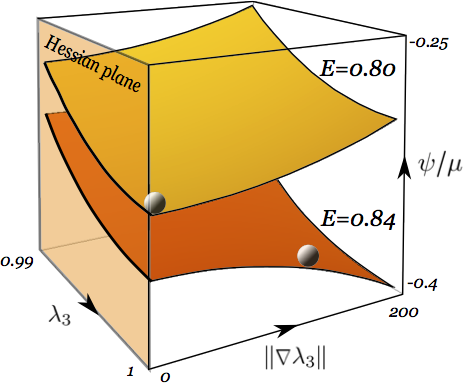You are here
Catastrophic thinning of dielectric elastomers
Consider a thin dielectric plate with conducting faces: when will it break if a voltage is applied? If it is rigid it will break once its dielectric strength is overcome by the voltage. But what if it is highly stretchable, like the elastomers used for soft actuators, stretchable electronics, or energy harvesters? The precise answer to that question is not known.
In a paper to appear on Physical Review Letters [1,2], together with Michel Destrade (NUI-Galway-Ireland), Domenico DeTommasi & Giuseppe Puglisi (Politecnico di Bari-Italy) we have addressed this long standing problem. Our analysis does not require the machinery of classical bifurcation methods. It provides a new paradigm for understanding electromechanical instability, which we find corresponds to a threshold where the electroelastic energy does not possess minimisers in a general class of homogeneous and non-homogeneous deformations.
For both unconstrained and constrained films, by addressing at the same time the problems of electro-creasing and pull-in instabilities, with and without pre-stretch and for a quite general class of incompressible materials, we obtain the following simple unifying formula for the dimensionless critical electric field:
Ecrit=(2/√3)*(W'(I)/μ)^(½)*min(1/λ1,1/λ2)
where (λ1,λ2) are the principal stretches in the plane of the thin membrane, W is the elastic energy density, I=λ1^2+λ2^2+(λ1 λ2)^(-2) is the first invariant of deformation and μ=2W'(3) is the inital shear modulus. The dimensionless electric field is here defined as E=(√ε /√μ)*(V/h), where ε is the dielectric permittivity, V the voltage and h the reference thickness of the membrane.
For creasing instability in absence of prestretch, our formula gives Ec=√(2/3)=0.816, less than 4% off the value Ec=0.85 obtained experimentally by Wang et al.[3]. For pull-in instability in absence of dead-loads, our formula gives Ec=√2/(3^(2/3))=0.680, falling squarely within the range of the experimental values measured by Pelrine et al. [4].
In presence of prestretch, our formula captures the fundamental features of both electro-creasing and pull-in instability. Relative to pull-in, in the figure at left the curves a,b,c,d are the homogeneous loading paths for different applied dead loads to a silicone thin membrane. The intersections of these curves with the blue critical voltage curve correspond to catastrophic thinning, which is in very good agreement with the experimental measurements of Huang et al.[5].


In the right figure, we plot the critical electric field versus prestretch for electro-creasing. The blue curves reproduce the peculiar "U-shape" that was experimentally measured by Wang et al. [6] for this type of instability. The idea behind our derivation is that above the critical electric field, the electroelastic free energy ceases to be convex in the vector (Grad λ3)=(∂λ3/∂X1,∂λ3/∂X2), where λ3 is the stretch of the thin membrane in the thickness direction and (X1,X2) are in-plane coordinates. The vector Grad λ3 accounts for deformation inhomogeneities. For a thin membrane, the electroelastic free energy can be asymptotically expanded in the (small) reference thickness as
ψ(λi,Grad λ3)=h φ(λi)+ h³ (α1(λi)(∂λ3/∂X1)²+α2(λi)(∂λ3/∂X2)²),
where i=1,2. While homogeneous configurations correspond to ∂φ(λi)/∂λi=0, this energy becomes non-convex in Grad λ3 as soon as one of the two functions α1-α2 becomes negative. This happens when the electric field overcomes a critical threshold, corresponding to the formula for Ec given above, see the figure below that refers to electrocreasing. The total free energy clearly becomes non-convex in Grad λ3 above Ec=0.816.

With our analysis, that is simply based on the inspection of loss of convexity of ψ(λi,Grad λ3) rather than on lengthy bifurcation methods, we foster new experimental campaigns and new analytical studies to generate a finer physical picture of the catastrophic thinning phenomenon in soft dielectrics. You may find more details in the forthcoming paper on PRL or on its ArXiV version referenced below.
Any comment will be gladly welcome!
Kind regards,
Giuseppe
========
[1] https://journals.aps.org/prl/accepted/5f076Y18Kbb1ac4ed8f93f49a3ee764f0d...
[2] https://arxiv.org/pdf/1610.03257v1.pdf
[3] Wang Q., Zhang L., Zhao X., Phys. Rev. Lett. 106, 118301 (2011)
[4] Pelrine R. E., Kornbluh R. D., Joseph J. P., Sensors Actu. A64, 77–85 (1998)
[5] Huang J., Li T., Foo C. C., Zhu J., Clarke D. R., Suo Z., Appl. Phys. Lett. 100, 041911 (2012)
[6] Wang Q., Tahir M., Zang J., Zhao X., Adv. Mater., 24, 1947–1951 (2012)
- peppezurlo's blog
- Log in or register to post comments
- 10877 reads


Comments
Hi Giuseppe,
Hi Giuseppe,
Interesting work! Another mode of electro-mechanical instability in soft dieletric is so-called electro-cavitation.
http://www.web.mit.edu/zhaox/www/papers/40.pdf
I would like to know the applicability of your method on electro-cavitation.
BTW, a recent review paper on various modes of deformation and instabilities in soft dielectrics can be found
http://www.web.mit.edu/zhaox/www/papers/62.pdf
Regards,
Xuanhe
Dear Xuanhe, Thanks! And
Dear Xuanhe,
Thanks! And thank you for the link to your review, a great read!We didn't know about electro-cavitation; we're confident that our analysis can be extended to that case too. So far we were focussing on the occurrence of patterns in thin electro elastic membranes, it seems that much can be still described by our approach, especially in relation to thinning. Thanks once again Xuanhe! Kind regards, Giuseppe
Hi
Dear Giuseppe
Indeed an interesting relation!
I feel a similar relation can also be derived for instabilities in the transient mode of actuation. The following two articles may be of interest to you:
http://appliedmechanics.asmedigitalcollection.asme.org/article.aspx?arti...
http://arc.aiaa.org/doi/pdf/10.2514/1.J054062
Thanks.
-Manish
Dear Manish,
Dear Manish, thank you!
Your approach is a relly interesting, also because it is already energy-based, that smoothens the application of our theory!
Thank you for posting these articles, we will read them carefully!
Kind regards,
Giuseppe